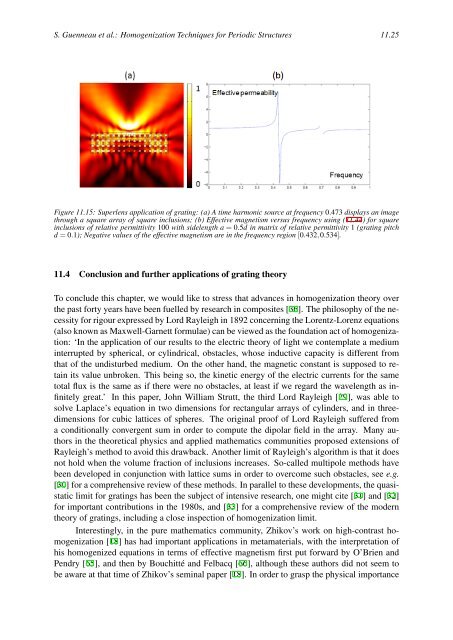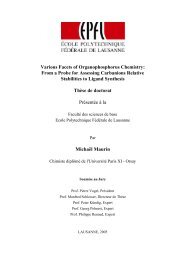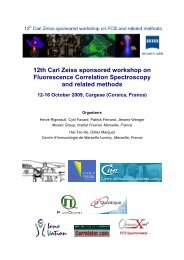GratinGs: theory and numeric applications - Institut Fresnel
GratinGs: theory and numeric applications - Institut Fresnel
GratinGs: theory and numeric applications - Institut Fresnel
Create successful ePaper yourself
Turn your PDF publications into a flip-book with our unique Google optimized e-Paper software.
S. Guenneau et al.: Homogenization Techniques for Periodic Structures 11.25<br />
Figure 11.15: Superlens application of grating: (a) A time harmonic source at frequency 0.473 displays an image<br />
through a square array of square inclusions; (b) Effective magnetism versus frequency using (11.44) for square<br />
inclusions of relative permittivity 100 with sidelength a = 0.5d in matrix of relative permittivity 1 (grating pitch<br />
d = 0.1); Negative values of the effective magnetism are in the frequency region [0.432,0.534].<br />
11.4 Conclusion <strong>and</strong> further <strong>applications</strong> of grating <strong>theory</strong><br />
To conclude this chapter, we would like to stress that advances in homogenization <strong>theory</strong> over<br />
the past forty years have been fuelled by research in composites [36]. The philosophy of the necessity<br />
for rigour expressed by Lord Rayleigh in 1892 concerning the Lorentz-Lorenz equations<br />
(also known as Maxwell-Garnett formulae) can be viewed as the foundation act of homogenization:<br />
‘In the application of our results to the electric <strong>theory</strong> of light we contemplate a medium<br />
interrupted by spherical, or cylindrical, obstacles, whose inductive capacity is different from<br />
that of the undisturbed medium. On the other h<strong>and</strong>, the magnetic constant is supposed to retain<br />
its value unbroken. This being so, the kinetic energy of the electric currents for the same<br />
total flux is the same as if there were no obstacles, at least if we regard the wavelength as infinitely<br />
great.’ In this paper, John William Strutt, the third Lord Rayleigh [29], was able to<br />
solve Laplace’s equation in two dimensions for rectangular arrays of cylinders, <strong>and</strong> in threedimensions<br />
for cubic lattices of spheres. The original proof of Lord Rayleigh suffered from<br />
a conditionally convergent sum in order to compute the dipolar field in the array. Many authors<br />
in the theoretical physics <strong>and</strong> applied mathematics communities proposed extensions of<br />
Rayleigh’s method to avoid this drawback. Another limit of Rayleigh’s algorithm is that it does<br />
not hold when the volume fraction of inclusions increases. So-called multipole methods have<br />
been developed in conjunction with lattice sums in order to overcome such obstacles, see e.g.<br />
[30] for a comprehensive review of these methods. In parallel to these developments, the quasistatic<br />
limit for gratings has been the subject of intensive research, one might cite [31] <strong>and</strong> [32]<br />
for important contributions in the 1980s, <strong>and</strong> [33] for a comprehensive review of the modern<br />
<strong>theory</strong> of gratings, including a close inspection of homogenization limit.<br />
Interestingly, in the pure mathematics community, Zhikov’s work on high-contrast homogenization<br />
[18] has had important <strong>applications</strong> in metamaterials, with the interpretation of<br />
his homogenized equations in terms of effective magnetism first put forward by O’Brien <strong>and</strong><br />
Pendry [65], <strong>and</strong> then by Bouchitté <strong>and</strong> Felbacq [66], although these authors did not seem to<br />
be aware at that time of Zhikov’s seminal paper [18]. In order to grasp the physical importance













